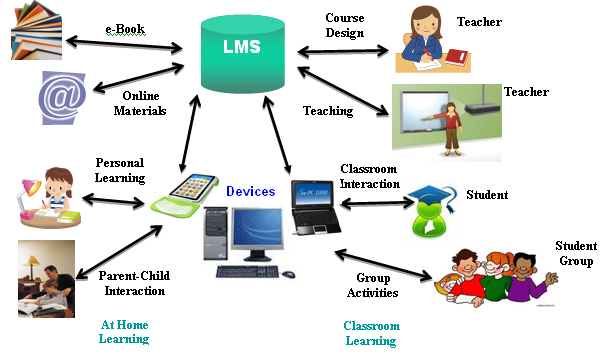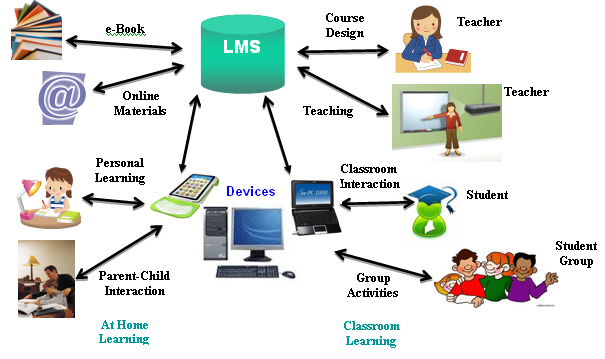
Open Source Learning Management System helps you create effective online teaching and learning modules in a private collaborative environment. It is powerful, secure and open platform used for eLearning and other commercial purposes.
Open Source technology is the one where source code is freely available to the developer community for reuse and modification. It can be used for learning and development purposes. Developers can make improvements and share it with a wider community. Open Source technology benefits several educational institutions and other organizations. The code of Open learning management system is widely available for reuse in development of newer learning or content management systems. Several developers examine the code for identifying bugs and fixing it.
A Learning Management System (LMS) is software that automates the different aspects of training such as tracking courses in a catalog, registering users, recording data, displaying students’ or participants’ progress toward certification, and providing reports to managers. These systems also serve as a platform to deliver e-Learning to people.
Prominent features of an LMS are
- Course Management such as updating lists of courses, registration syllabus, etc.
- Self-assessment quizzes
- Lesson tools like Authoring for contents (structured XML or HTML), chapter quizzes or tests.
- Other tools in the form of Home page, self tests, bookmarks, progress tracking and many more
- Asynchronous Communication in the form of email, forums
- Synchronous Communication in the form of chat, whiteboard, teleconferencing
- Student Management Tools: progress tracking, on-line grading (assessment) and others
- Learner feedback: course evaluation surveys, test evaluation surveys and others
Open Source LMS is flexible and can be developed keeping in mind specific needs of the training providing organization. It is free to use without any additional costs like hardware costs. Open Source Learning Management System is of great significance to universities, schools and other educational institutions.
Several Learning Management Systems are available in the market today and here’s a list of some popular Open source learning management systems:
- Moodle
- Sakai
- eFront
- OLAT
- aTutor
- .LRN
- Dokeos
- Fedena
- ILIAS
- LAMS
- OpenOLAT
- Sakai
- Canvas
- Chamilo
- Claroline
- SWAD
- WeBWorK
It could be a tough call to choose from the above list without the knowledge of what is being offered by each one of those. Some of the leading Open Source Learning Management Systems are described below to assist you in making an informed decision.
Moodle
Moodle is an Open source LMS built on LAMP (Linux, Apache, MySQL and PHP). Mainly used for educational purposes, it is free LMS software but certain additional peripherals can cost money. It should be stressed that open source solutions can cost as much or more than proprietary software because of the internal technology resources you might need to devote to implement and maintain them.
Exclusive Features:
- Student dashboards, progress tracking and support for multimedia classes
- Simple to deploy and implement
- Support for third party add-ons
- PDF documents can be generated easily
- Drag and drop feature for adding files
However, it is difficult to learn and understand for a layman. Some users also complain that they find it difficult to manage learners in Moodle.
Sakai
Sakai is an open source LMS, built on Java unlike Moodle. Though it is an open source platform, but only certain major stakeholders and commercial partners have the authority to contribute to the source code. It is primarily used by academic institutions for educational purposes.
Exclusive Features:
- Integration with Google docs
- View site usage statistics
- Includes tools such as wiki , online testing, presentation slides
- Display external web pages
- Create innovative sites from templates with tools
- Contains tools for portfolio based activities
Ability to use Dropbox well
Another fact about Sakai is that it is mainly coded in Java and there can be issues if using older versions of browsers. Developers of Java are more expensive and hard to find. It does not have as much community of support, plugins and add-ons as there are with Moodle.
eFront
eFront is an open source LMS with a paid and hosted version available. It is mainly developed for online learning and educational purposes. It provides requisite tools are making assignments, creating content, creating quizzes and others as well.
Exclusive Features:
- An intuitive icon-based interface
- A course creation tool
- Internal chat
- Built-in forums
- Superior security systems
- Progress tracking
- Communication tools like forum, chat and others as well
There may be some technology issues that may disrupt training goals.
.LRN (dot learn)
.LRN is enterprise-class open source software for developing eLearning and web based learning content. It was originally developed at MIT. It offers support to multiple languages, dialects and time zones.
Exclusive Features:
- Assessment
- Homework dropbox
- Gradebook/ Evaluation
- Web blogger
- SCORM Display
- Student tracking data can be exported
However, its major drawback is about inconsistencies in interface.
Dokeos
It provides live communication by organizing meetings and conferences face-to-face. It delivers e Learning material through premium quality video content.
Exclusive Features:
- Progress tracking
- Develop your training material
- Ubiquitous access
- Easy course creation
- Integrate your existing content
It does not have appropriate support system with issues pending on forums.
Out of the platforms discussed above, Moodle is widely acclaimed and one of the most popular software offering thousands of learning environments across the world. Moodle helps in easy import of files from Dropbox, Google Docs, Youtube and others as well. A Moodle site offers you forum to ask questions, FAQs, manuals and books. It is one of the most trusted platforms for developing eLearning content. Known for features to enhance security and integration with related plug-ins, it helps in creating learning environment as per specific needs of customers.




















